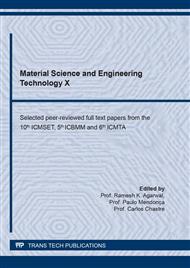[1]
S. Thambiraj, D. Ravi Shankaran, Appl Surf Sci 412 (2017) 405-416.
Google Scholar
[2]
S. Shaaban, M. Nasr, Adv Biotech & Micro 8 (2018).
Google Scholar
[3]
S. Huang, R. Tao, A. Ismail, Y. Wang, Polymers (Basel) 12 (2020).
Google Scholar
[4]
K. Rahbar Shamskar, H. Heidari, A. Rashidi, Ind Crops Prod 93 (2016) 203-211.
Google Scholar
[5]
D. Trache, A.F. Tarchoun, M. Derradji, T.S. Hamidon, N. Masruchin, N. Brosse, M.H. Hussin, Front Chem 8 (2020) 392.
DOI: 10.3389/fchem.2020.00392
Google Scholar
[6]
Z. Yu, L. Sun, W. Wang, W. Zeng, A. Mustapha, M. Lin, Ind Crops Prod 112 (2018) 412-419.
Google Scholar
[7]
J. Shojaeiarani, D.S. Bajwa, S. Chanda, Composites Part C: Open Access 5 (2021).
Google Scholar
[8]
E. Lam, U.D. Hemraz, Nanomaterials (Basel) 11 (2021).
Google Scholar
[9]
H.I. Fathi, A.H. El-Shazly, M.F. Elkady, K. Madih, Materials Science Forum 928 (2018) 83-88.
DOI: 10.4028/www.scientific.net/msf.928.83
Google Scholar
[10]
R.E. Abou-Zeid, E.A. Hassan, F. Bettaieb, R. Khiari, M.L. Hassan, J Nanomater 2015 (2015) 1-11.
Google Scholar
[11]
B. Abdelrahman, F. Alaa, E.L.M. Shahira H, E.-F. Esmail M, K. Elbadawy A, B. Mohamed, J Appl Pharm Sci (2020).
Google Scholar
[12]
B. Sun, M. Zhang, Q. Hou, R. Liu, T. Wu, C. Si, Cellulose 23 (2015) 439-450.
Google Scholar
[13]
M.K.D. Rambo, M.M.C. Ferreira, J Braz Chem Soc (2015).
Google Scholar
[14]
M.G. Aguayo, A. Fernandez Perez, G. Reyes, C. Oviedo, W. Gacitua, R. Gonzalez, O. Uyarte, Polymers (Basel) 10 (2018).
Google Scholar
[15]
M. Thakur, A. Sharma, V. Ahlawat, M. Bhattacharya, S. Goswami, Materials Science for Energy Technologies 3 (2020) 328-334.
Google Scholar
[16]
B.W. Chieng, S.H. Lee, N.A. Ibrahim, Y.Y. Then, Y.Y. Loo, Polymers (Basel) 9 (2017).
Google Scholar
[17]
W.H. Danial, R. Mohd Taib, M.A. Abu Samah, R. Mohd Salim, Z. Abdul Majid, RSC Advances 10 (2020) 42400-42407.
DOI: 10.1039/d0ra07972c
Google Scholar
[18]
H. Liu, D. Liu, F. Yao, Q.J.B.t. Wu, 101 (2010) 5685-5692.
Google Scholar
[19]
M. Maciel, K. Benini, H.J.C. Voorwald, M.O.H. Cioffi, Int J Biol Macromol 126 (2019) 496-506.
Google Scholar
[20]
W.T. Wulandari, A. Rochliadi, I.M. Arcana, IOP Conf Ser: Mater Sci Eng 107 (2016).
Google Scholar
[21]
C. Trilokesh, K.B.J.S.r. Uppuluri, 9 (2019) 1-8.
Google Scholar
[22]
B.W. Chieng, S.H. Lee, N.A. Ibrahim, Y.Y. Then, Y.Y.J.P. Loo, 9 (2017) 355.
Google Scholar
[23]
A. Khenblouche, D. Bechki, M. Gouamid, K. Charradi, L. Segni, M. Hadjadj, S. Boughali, Polímeros 29 (2019).
DOI: 10.1590/0104-1428.05218
Google Scholar
[24]
A. Osorio-Madrazo, M. Eder, M. Rueggeberg, J.K. Pandey, M.J. Harrington, Y. Nishiyama, J.L. Putaux, C. Rochas, I. Burgert, Biomacromolecules 13 (2012) 850-856.
DOI: 10.1021/bm201764y
Google Scholar
[25]
T. Owoyokun, C.M.P. Berumen, A.M. Luévanos, L. Cantú, A.C.L. Ceniceros, Biointerface Research in Applied Chemistry 11 (2020) 11797-11816.
Google Scholar


